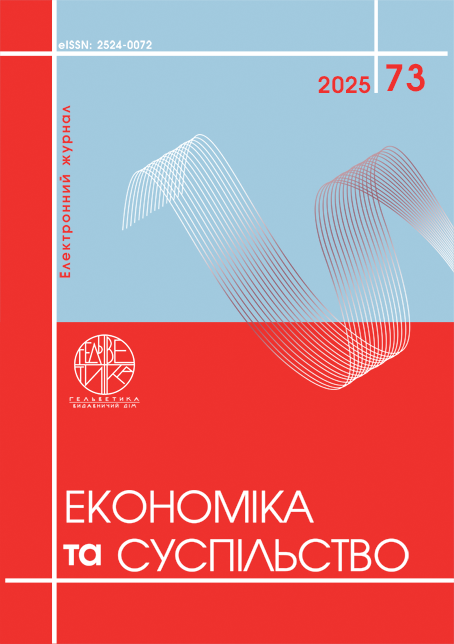TECHNOLOGY TRANSFER AS A HIDDEN MECHANISM OF VENTURE INVESTMENT IN INNOVATIVE STARTUPS
Abstract
This article examines technology transfer as a concealed yet fundamental aspect of venture investment at the early stages of innovative startup development. Rather than serving solely research commercialization, technology transfer acts as a strategic mechanism of non-monetary institutional investment, particularly during the pre-seed phase when startups lack liquidity and assets to attract conventional capital. Intangible contributions, including intellectual property rights, access to research infrastructure, expert mentorship, and integration into networks, substitute for early financial investment by reducing uncertainty and enhancing investment readiness. The methodology applies conceptual modeling, structural-functional analysis, and institutional theory. A staged framework illustrates the evolution of non-financial resources into venture-attractive value, progressing from technology disclosure and legal protection toward commercialization or venture capital attraction, with institutional participation interpreted as latent investment capacity critical for startup viability but often omitted from financial reporting. Findings reveal that technology transfer activities embody venture capital logic, characterized by long-term orientation, risk asymmetry, deferred returns, and strategic alignment between donor institutions and entrepreneurial teams. This conceptualization redefines technology transfer as an integral element of innovation financing infrastructure, positioning universities, research institutes, and technology transfer offices as proactive agents of entrepreneurial capital formation. From a practical perspective, the study emphasizes the importance of formally recognizing technology transfer within national innovation policy and early-stage financing frameworks. Institutional contributions should be systematically evaluated and integrated into startup support programs to improve startup potential assessment, strengthen innovation ecosystems, and support the development of hybrid models.
References
Бєлялов Т. Е., Гірник Я. С. Стартап-проєкт як форма розвиту інноваційного підприємництва. Journal of strategic economic research. 2024. № 2. С. 8–15. URL: https://doi.org/10.30857/2786-5398.2024.2.1 (дата звернення: 28.04.2025).
Bellucci A., Gucciardi G., Nepelski D. Public grants beneficiaries and venture capital-backed firms: a tale of two funding strategies. The journal of technology transfer. 2025. URL: https://doi.org/10.1007/s10961-024-10180-9 (date of access: April 28, 2025).
Borrás S., Gerli F., Cenzato R. Technology transfer offices in the diffusion of transformative innovation: rethinking roles, resources, and capabilities. Technological forecasting and social change. 2024. Vol. 200. Art. 123157. URL: https://doi.org/10.1016/j.techfore.2023.123157 (date of access: April 28, 2025).
Dyba M. Infrastructure of startups’ venture financing. Actual problems of economics. 2024. Vol. 1. No. 278. С. 192–199. URL: https://doi.org/10.32752/1993-6788-2024-1-278-192-199 (date of access: April 28, 2025).
Eidlisz J., von Simson I., Gold-von Simson G. Exploring the current state of technology transfer in the United States: perspectives and improvement strategies from the experts. Frontiers in research metrics and analytics. 2024. Vol. 9. URL: https://doi.org/10.3389/frma.2024.1376185 (date of access: April 28, 2025).
Hong J., Cha J., Park B., Park K. Evaluation framework for facilitating the technology transfers of universities: focusing on the perspective of technology donors. PLOS ONE. 2023. Vol. 18. No. 12. Art. e0293951. URL: https://doi.org/10.1371/journal.pone.0293951 (date of access: April 28, 2025).
Kirihata T. Impact of technology transfer offices on university spin-off bankruptcy. The journal of technology transfer. 2024. URL: https://doi.org/10.1007/s10961-024-10129-y (date of access: April 28, 2025).
Kruger S., Steyn A. A. Enhancing technology transfer through entrepreneurial development: practices from innovation spaces. The journal of technology transfer. 2019. Vol. 45. No. 6. С. 1655–1689. URL: https://doi.org/10.1007/s10961-019-09769-2 (date of access: April 28, 2025).
Martínez-Ardila H., Castro-Rodriguez Á., Camacho-Pico J. Examining the impact of university-industry collaborations on spin-off creation: evidence from joint patents. Heliyon. 2023. Vol. 9. No. 9. Art. e19533. URL: https://doi.org/10.1016/j.heliyon.2023.e19533 (date of access: April 28, 2025).
Rozghon O. Technology transfer mechanism and its implementation in the innovation process. Law and innovations. No. 1(37), 2022. С. 22–30. URL: https://doi.org/10.37772/2518-1718-2022-1(37)-3 (date of access: April 28, 2025).
Startups and innovation ecosystems in emerging markets / ed. by M. d. M. Oliveira, F. R. Cahen, F. M. Borini. Cham : Springer International Publishing, 2019. URL: https://doi.org/10.1007/978-3-030-10865-6 (date of access: April 28, 2025).
Veer T., Yang P., Riepe J. Ventures' conscious knowledge transfer to close partners, and beyond: a framework of performance, complementarity, knowledge disclosure, and knowledge broadcasting. Journal of business venturing. 2022. Vol. 37. No. 3. Art. 106191. URL: https://doi.org/10.1016/j.jbusvent.2022.106191 (date of access: April 28, 2025).
Bielialov, T. E., & Hirnyk, Ya. S. (2024). Startap-proiekt yak forma rozvytku innovatsiinoho pidpryiemnytstva [Startup project as a form of innovative entrepreneurship development]. Journal of Strategic Economic Research, (2), pp. 8–15. https://doi.org/10.30857/2786-5398.2024.2.1 (accessed April 28, 2025).
Bellucci, A., Gucciardi, G., & Nepelski, D. (2025). Public grants beneficiaries and venture capital-backed firms: A tale of two funding strategies. The Journal of Technology Transfer. https://doi.org/10.1007/s10961-024-10180-9 (accessed April 28, 2025).
Borrás, S., Gerli, F., & Cenzato, R. (2024). Technology transfer offices in the diffusion of transformative innovation: Rethinking roles, resources, and capabilities. Technological Forecasting and Social Change, 200, 123157. https://doi.org/10.1016/j.techfore.2023.123157 (accessed April 28, 2025).
Dyba, M. (2024). Infrastructure of startups’ venture financing. Actual Problems of Economics, 1(278), pp. 192–199. https://doi.org/10.32752/1993-6788-2024-1-278-192-199 (accessed April 28, 2025).
Eidlisz, J., von Simson, I., & Gold-von Simson, G. (2024). Exploring the current state of technology transfer in the United States: Perspectives and improvement strategies from the experts. Frontiers in Research Metrics and Analytics, 9. https://doi.org/10.3389/frma.2024.1376185 (accessed April 28, 2025).
Hong, J., Cha, J., Park, B., & Park, K. (2023). Evaluation framework for facilitating the technology transfers of universities: Focusing on the perspective of technology donors. PLOS ONE, 18(12), e0293951. https://doi.org/10.1371/journal.pone.0293951 (accessed April 28, 2025).
Kirihata, T. (2024). Impact of technology transfer offices on university spin-off bankruptcy. The Journal of Technology Transfer. https://doi.org/10.1007/s10961-024-10129-y (accessed April 28, 2025).
Kruger, S., & Steyn, A. A. (2019). Enhancing technology transfer through entrepreneurial development: Practices from innovation spaces. The Journal of Technology Transfer, 45(6), pp. 1655–1689. https://doi.org/10.1007/s10961-019-09769-2 (accessed April 28, 2025).
Martínez-Ardila, H., Castro-Rodriguez, Á., & Camacho-Pico, J. (2023). Examining the impact of university-industry collaborations on spin-off creation: Evidence from joint patents. Heliyon, 9(9), e19533. https://doi.org/10.1016/j.heliyon.2023.e19533 (accessed April 28, 2025).
Oliveira, M. d. M., Cahen, F. R., & Borini, F. M. (Eds.). (2019). Startups and innovation ecosystems in emerging markets. Springer International Publishing. https://doi.org/10.1007/978-3-030-10865-6 (accessed April 28, 2025).
Rozghon, O. (2022). Technology transfer mechanism and its implementation in the innovation process. Law and Innovations, 1(37), pp. 22–30. https://doi.org/10.37772/2518-1718-2022-1(37)-3 (accessed April 28, 2025).
Veer, T., Yang, P., & Riepe, J. (2022). Ventures’ conscious knowledge transfer to close partners, and beyond: A framework of performance, complementarity, knowledge disclosure, and knowledge broadcasting. Journal of Business Venturing, 37(3), 106191. https://doi.org/10.1016/j.jbusvent.2022.106191 (accessed April 28, 2025).

This work is licensed under a Creative Commons Attribution 4.0 International License.


